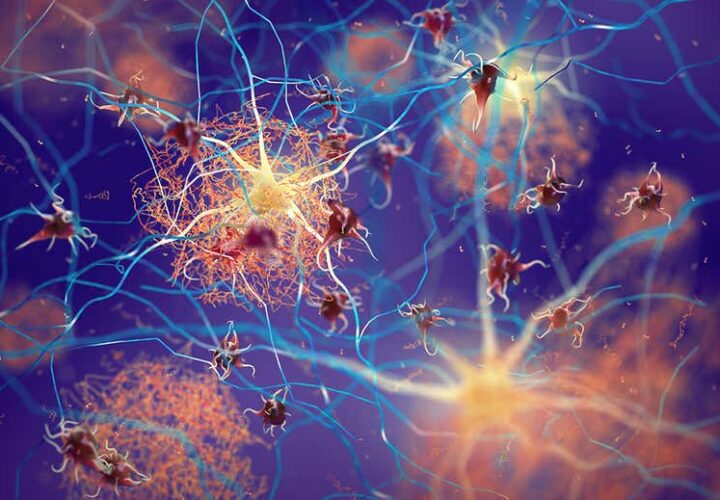As part of our BrainTalk series, Being Patient spoke with Jack Price, professor of developmental neurobiology at King’s College London, about how stem cell therapies could help repair the brain.
Clinical trials of stem cell therapies are now underway to repair the damaged cells of people with Parkinson’s disease and age-related macular degeneration. Being Patient spoke with Jack Price, professor of developmental neurobiology at King’s College London and author of the book The Future of Brain Repair, about the potential and challenges of repairing the brain with stem cell therapy.
- Stem cells can develop into many different types of cells in the body.
- In 2006, researchers at Kyoto University made a groundbreaking discovery: By genetically manipulating a specialized type of cell, they created cells known as induced pluripotent stem cells (iPSCs) that can generate tissues in the body.
- IPSC technologies have paved the way for scientists in the field of Alzheimer’s research to develop brain models of the disease and better understand the biological mechanisms involved in Alzheimer’s.
- There are no licensed stem cell therapy to treat brain disorders in the country, or anywhere in the world. Untested treatments which have proliferated in the U.S. are highly likely to be ineffective.
Being Patient: What is stem cell therapy?
Prof. Jack Price: It’s the transplantation of stem cells, either directly into the brain or in a way that gives them access to the brain and influence the brain, to bring about a therapeutic effect.
Being Patient: Are there stem cells in the brain?
Prof. Jack Price: For many years, neuroscientists didn’t think there were stem cells in the brain. We now know there are. We know about a population [of stem cells] that’s become very important in our understanding of Alzheimer’s disease and in mood disorders like anxiety and depression. These are stem cells that are found in a part of the brain called the hippocampus.
But by and large, the brain doesn’t have stem cells, unlike skin and other tissues in the body. The blood is the classic [example]: There’s a population of stem cells in the bone marrow that regenerates blood all the time.
Being Patient: What makes stem cells so special and why are they a focus of research?
Prof. Jack Price: The definition of stem cells is a population of cells that gives rise to other types of cells. In neural stem cells, precursor cells can make adult brain cells, nerve cells, glial cells, all the different cell types that make up the brain. If you have a disease like Alzheimer’s or any other neurodegenerative disease, where we know the key pathology is the loss of nerve cells, your brain doesn’t normally have the ability to replace those lost brain cells. The idea was [that] if you put stem cells where the loss of brain cells has taken place, maybe those stem cells would replace the lost cells.
Being Patient: What is the potential of stem cell therapy in treating neurodegenerative diseases?
Prof. Jack Price: There’s a piece of absolutely brilliant stem cell science that was done by Shinya Yamanaka in Kyoto in 2006. He showed you could effectively take any cell through a very straightforward genetic manipulation that he discovered, [and] turn them into what we call pluripotent stem cells, which are cells that can make any cell type in the body. They also have an ability that other stem cells generally don’t: They can build tissue. If you grow them in a little culture dish, they can start to make little pieces of brain called organoids or cerebroids. This was a groundbreaking technology.
In Parkinson’s disease, there’s enormous progress and clinical trials are underway now. We know more about the pathology of Parkinson’s disease [than in Alzheimer’s]. The pathology of Alzheimer’s turns out to be quite complex, and we’ve had, over the years, quite a few ideas about how it worked. But [turning] those into actual therapies hasn’t quite worked as we expected, and we keep having to go back and rethink what’s going on in Alzheimer’s.
The pathology of Parkinson’s disease is also difficult. It’s not trivial. But at the same time, one thing is clear: a lot of the pathology is associated with the loss of a particular population of nerve cells — the midbrain dopaminergic cells. We can start with these pluripotent stem cells and make them make precisely the right type of dopaminergic cell that we know is lost in Parkinson’s disease.
This is built on 30 [to] 40 years of research of people trying to find exactly the right cell type to work [with] in Parkinson’s disease. They had some early success and fell backwards. But this technology looks much more precise than everything anybody’s ever tried before.
In age-related macular degeneration, the disease of the eye where you lose your retinal photoreceptors, there are very clever strategies now where people are using these pluripotent stem cells to make a thing called a retinal pigment epithelium. It lies behind the retina, but it’s what supports the photoreceptors. It turns out, that’s what goes wrong in age-related macular degeneration.
Being Patient: Are there any stem cell therapy approved to treat brain disorders?
Prof. Jack Price: There are no licensed stem cell therapy for any brain disorders anywhere in the world for the simple reason [that] nobody has shown one works. There are a lot of stem cell clinics in the U.S. and somewhat fewer elsewhere who are offering cell therapies that are untested. They’ll put stem cells into you for any disorder you’ve got. Those cell therapies do not work.
A lot of genuine companies are trying to get these cell therapies to work in clinical trials and falling flat on their face quite often, despite their best efforts. 90% of clinical trials fail, and that’s clinical trials of conventional drugs by drug companies that know what they’re doing.
What do you suppose is the chance with a stem cell therapy [that] we don’t really understand how it works, [that] we don’t quite know how to manufacture it properly, [and that] we don’t quite know what cells we really want, of working? The chance is almost zero.
The interview has been edited for length and clarity.
Contact Nicholas Chan at nicholas@beingpatient.com


